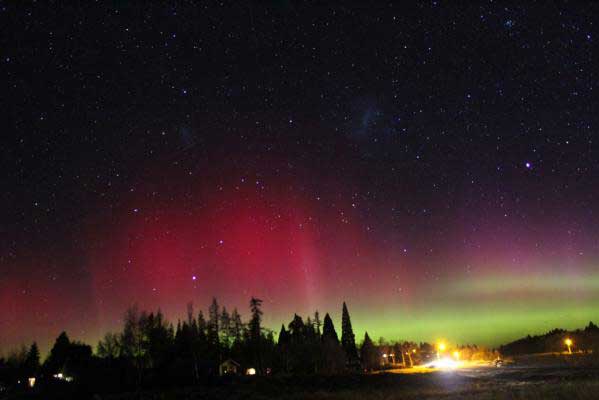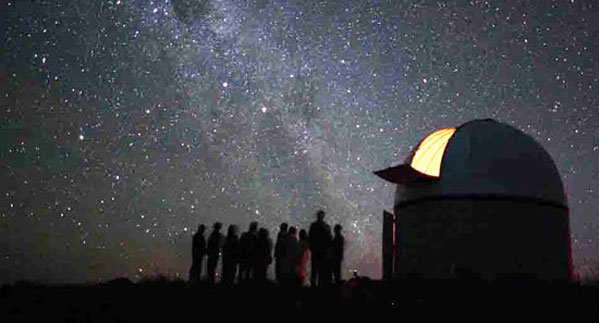
We have been captivated by the Southern Lights or 'Aurora Australis' ever since the earliest official record of its sighting by Captain Cook in 1773. We know however from Australian Aboriginal culture that this natural phenomena has been around for thousands of years. Travelers will venture from far and wide to increase their chances of catching a glimpse for themselves and find themselves in New Zealand or Australia to get the best opportunity.

What are the Southern Lights?
The Southern Lights, also known as the Aurora Australis, is a natural light display in the Earth’s sky. This incredible display can provide stunning shimmers of pink, red, green, and purple light. This breathtakingly vibrant optical phenomenon is named after the Roman goddess of the dawn (Aurora).
How do the Southern Lights Form?
The varying colors of the aurora are produced by different gases in the atmosphere reacting with the solar particles. These stunning displays of colored light result from collisions between electrically charged particles in Earth's atmosphere and charged particles from the sun, often delivered through solar flares.
When can you see the Southern Lights?
The best time to witness the Aurora Australis is from March to September, when the nights are longer. During the equinoxes, the Earth’s magnetic fields point in opposite directions, allowing more solar wind to penetrate, causing strong geomagnetic activity. keep in mind that that there is no fixed schedule and they occur at short notice.
Best Conditions for the Southern Lights:
- In a remote area away from light pollution
- A night with minimal cloud cover
- A clear view to the south
- Late at night
- In the winter
Can you see the Southern Lights with the Naked Eye?
A camera with a long exposure can capture more detail and the vivid colors of the Southern Lights but in ideal conditions, the Aurora Australis can occasionally be seen without the use of a camera. Typically, it appears as vertical beams of white light, but if the display is particularly strong, you might catch glimpses of its vibrant colors with the naked eye.
Photo by Matt Hall
Where can you see the Southern Lights?
New Zealand:
The closer you are to the south pole, the greater the chance of seeing a strong display. That is why you are most likely to see them in the South Island of New Zealand.
- Queenstown & Wanaka
- Fiordland National Park
- Aoraki/Mount Cook National Park
- Tekapo
Australia:
Being the most southern state in Australia, Tasmania is the best place for Aurora hunting.
- Bruny Island - specifically the southernmost point of The Neck and Cloudy Bay
- Satellite Island
- Cradle Mountain-lake St Clair National Park
Dark Sky Reserves
Dark sky reserves are internationally recognised as having some of the planets clearest and darkest night skies. 2 of the worlds 22 dark sky reserves are located in New Zealand.
- The Wairarapa Dark Sky Reserve - located in the North Island
- Aoraki Mackenzie International Dark Sky Reserve - located in the South Island and is the worlds biggest dark sky reserve
Due to its southern location the Aoraki Mackenzie International Dark Sky Reserve offers a better chance of seeing the Southern Lights. Dark sky reserves are also amazing spots to go stargazing. Mount John Observatory in Lake Tekapo is not to be missed. Read everything you need to know about Stargazing in New Zealand.
Exciting Aurora News From NASA
NASA has predicted heightened solar activity through the end of 2025, offering a thrilling opportunity for aurora hunters and amateur astronomers alike, sparking excitement among both visitors and locals.
Recent Posts
Blog Categories
Blog archives
- February 2025 (3)
- January 2025 (6)
- December 2024 (12)
- November 2024 (3)
- October 2024 (2)
- July 2024 (2)
- May 2024 (12)
- April 2024 (2)
- March 2024 (2)
- January 2024 (2)
- November 2023 (10)
- October 2023 (4)
- August 2023 (1)
- May 2023 (2)
- April 2023 (2)
- March 2023 (17)
- February 2023 (4)
- January 2023 (4)
- December 2022 (11)
- November 2022 (7)
- October 2022 (1)
- May 2022 (1)
- March 2022 (3)
- February 2022 (3)
- January 2022 (1)
- December 2021 (1)
- August 2021 (1)
- June 2021 (1)
- May 2021 (2)
- February 2021 (1)
- August 2020 (1)
- July 2020 (1)
- May 2020 (1)
- April 2020 (1)
- March 2020 (1)
- January 2020 (1)
- December 2019 (1)
- November 2019 (1)
- October 2019 (1)
- September 2019 (1)
- August 2019 (5)
- July 2019 (2)
- June 2019 (1)
- May 2019 (3)
- April 2019 (1)
- March 2019 (1)
- February 2019 (1)
- January 2019 (1)
- December 2018 (1)
- November 2018 (1)
- September 2018 (1)
- August 2018 (1)
- July 2018 (1)
- June 2018 (1)
- May 2018 (1)
- April 2018 (1)
- March 2018 (1)
- February 2018 (1)
- January 2018 (1)
- December 2017 (1)
- October 2017 (1)
- September 2017 (1)
- August 2017 (1)
- July 2017 (1)
- June 2017 (1)
- May 2017 (1)
- April 2017 (1)
- March 2017 (1)
- February 2017 (1)
- January 2017 (1)
- December 2016 (1)
- November 2016 (1)
- October 2016 (1)
- September 2016 (1)
- August 2016 (1)
- July 2016 (1)
- June 2016 (1)
- May 2016 (1)
- April 2016 (1)
- March 2016 (1)
- February 2016 (1)
- January 2016 (1)
- December 2015 (1)
- November 2015 (1)
- October 2015 (1)
- September 2015 (1)
- August 2015 (1)
- July 2015 (1)
- June 2015 (1)
- May 2015 (1)
- April 2015 (1)
- March 2015 (1)
- February 2015 (1)
- January 2015 (1)
- December 2014 (1)
- November 2014 (1)
- October 2014 (1)
- September 2014 (1)
- July 2014 (1)
- June 2014 (3)
- May 2014 (1)
- April 2014 (1)
- March 2014 (1)
- February 2014 (1)
- January 2014 (1)
- November 2013 (15)
- October 2013 (1)
- September 2013 (1)
- August 2013 (1)
- July 2013 (1)
- May 2013 (1)
- April 2013 (1)
- March 2013 (1)
- February 2013 (1)
- January 2013 (1)
- December 2012 (1)
- November 2012 (2)
- October 2012 (2)
- September 2012 (2)
- August 2012 (2)
- July 2012 (2)
- June 2012 (2)
- May 2012 (2)
- April 2012 (3)
- March 2012 (2)
- February 2012 (2)
- January 2012 (3)
- December 2011 (1)
- November 2011 (1)
- October 2011 (2)
- September 2011 (1)
- August 2011 (1)
- July 2011 (1)
- June 2011 (1)
- May 2011 (1)
- April 2011 (1)
- March 2011 (1)
- February 2011 (1)
- January 2011 (1)
- December 2010 (1)
- November 2010 (1)
- October 2010 (1)
- September 2010 (1)
- August 2010 (1)
- July 2010 (1)
- June 2010 (1)
- May 2010 (1)
- March 2010 (1)
- February 2010 (1)
- January 2010 (1)
- December 2009 (1)
- November 2009 (1)
- October 2009 (1)
- September 2009 (1)
- August 2009 (1)
- July 2009 (1)
- June 2009 (1)
- May 2009 (1)
- April 2009 (1)
- March 2009 (1)
- February 2009 (1)
- January 2009 (1)
- December 2008 (1)
- May 2005 (1)







